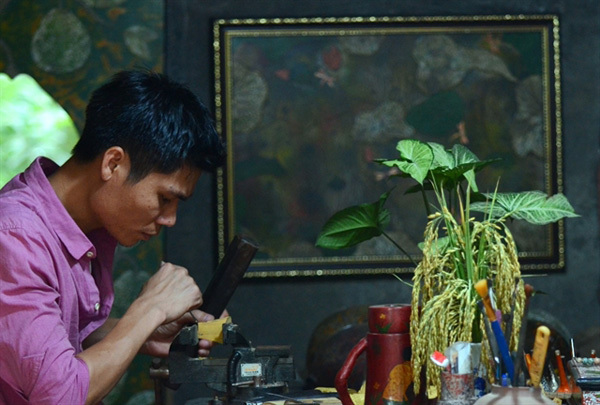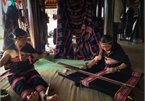They are not only protectors of the feet; they also silently reflect the inner thoughts, emotions, intellect, and cultural maturity of the wearer. They can also bear witness to a community, a group of people who wear them, value them, and bring them to the next level of wearable art.
Such attitudes drive a young woman from Hue who has taken her shoes to the wider world.
Local significance, global thinking
After graduating from college in 2008, Nguyen Ngoc Quynh Anh, then 23, ventured abroad to České Budějovice in the Czech Republic to start a new life selling goodies in a 500sq.m store.
Two years later, she moved to Strakonice and decided to get a business of her own off the ground. She noticed that guarantees on goods from the EU were usually for two years, whereas the goods she imported from China to sell were covered for much less time. She put all of her capital into opening a new store and stocking its shelves. Sales were slow, though, and outlays continued to exceed revenue. Problems mounted.
Quynh Anh resolved all of the problems one at a time and managed to remain in the foreign country. Life was tough, but not insurmountable.
She tossed and turned at night, however, trying to think of a way to make ends meet while leaving her personal imprint and making good use of her roots.
“Take local action with overall global thinking” was the mantra she adopted, and she decided to return to Hue in 2014 to find her market niche.
“At first I only thought about making a product that could be sold abroad, that bore Vietnamese culture and expertise,” she remembered. “But I had a hard time determining what that product might be.”
Her hometown of Hue was the royal capital of the Nguyen dynasty for 143 years, from 1802 to 1945. It was a magnet drawing in many craft guilds to serve the court and its demanding contingent: martial arts mandarins, men of letters, doctors, teachers, and artisans.
Traditional crafts need connoisseur clients to thrive and keep the work flowing. More than 80 traditional guilds are now operating in and around Hue, half of which are known nationwide.
Quynh Anh recalled she spent a great deal of time visiting traditional guilds to watch artisans work meticulously on every product.
She paid numerous visits to My Xuyen Village in Phong Hoa Commune, Phong Dien District, 40km north of Hue.
In 1802, when the first Emperor of the Nguyen dynasty ascended the throne, the court invited carpentry masters to begin building the capital. These masters were mostly from the north, but on their way to Hue they stopped at My Xuyen and took some young boys with them as apprentices. These young apprentices would later become the new generation of My Xuyen carpenters.
Their descendants have retained the craft to this day.
 |
| SIGNIFYING MARK: Royal seal for contemporary use. VNS Photo Tuan Hoang |
Back in the mid-19th century, wood carvers were at their best as the new dynasty constructed its Forbidden City. Ornate wooden palaces and homes were gradually being built.
Their expertise can still be seen in artworks and architecture. The level of carving techniques reached a pinnacle during this time. Hue has its own signature wooden houses, with ornate decorations, called nhà rường. The most beautiful were made by the wood carvers of My Xuyen.
Traditional values
Nearby is Tien Non Village in Phu Mau Commune, Phu Vang District, where Emperor Khai Dinh assigned master artisan Nguyen Duc Bui to restore all of the gilded woodwork in the Forbidden City.
The lacquer that gilded the woodwork was harvested from Phu Tho, a hilly region some 80km north of Hanoi or more than 750km from Hue.
In the mid-19th century a trip between the two locations could take months. The latex from the lacquer trees would be treated for three months until it separated into three levels, with each then coated on wood as appropriate.
Traditional lacquer in Hue has three purposes: to coat boats and wood, to gild with gold and silver leaf, and for lacquered bas relief.
The basic colours of traditional lacquer were mahogany, red, and black, as well as gold and silver from real gold and silver powder or in thin leaves. More natural colours were added later, such as blue, grey, egg-shell white, crab pink, and mother-of-pearl.
A finished lacquer product should have between five and seven layers of lacquer coating. The artisan then polishes the surface with water so that the layers underneath reveal themselves and give it a three-dimensional appearance.
Today’s Hue lacquer works are in new forms and continue to surprise aficionados. Regular objects, ornaments, and creative jewellery keep lacquer present in daily life and not just limited to artistic pieces adorning walls in galleries and private homes.
Ethnic tapestry
When Quynh Anh visited the mountainous districts of A Luoi and Nam Dong near Hue, she learned of the ethnic Ta Oi people’s traditional tapestry. The young entrepreneur met with master artisan Ho Thi Hop, who made the most difficult zèng works of art.
In September, Ta Oi women collect cotton from the hills to take home and make thread. The fibres are dyed and weaved into a new piece. Different sizes of cotton thread are used and nothing goes to waste.
The more decorative a zeng piece of cloth, the more value it possesses. Beautiful pieces play an important role in rituals, religious practices, and ancestor worshipping ceremonies. They also act as a valuable object a woman takes to confirm a serious relationship with a man. A future husband will offer his parents-in-law a piece of zeng cloth as a mark of respect.
From her trips, Quynh Anh first came upon the idea of creating special footwear. It must be suitable for all sizes and shapes of feet, while bearing local significance. The reason she wished to break into the footwear industry was because she had noticed that Vietnam was a major sneaker producer but didn’t have a local sneaker brand.
She wanted to change that.
Her footwear, she decided, must follow international quality standards, with designs in line with global trends, and bear features not found in other shoes.
After spending long periods on field trips to villages in Hue, Quynh Anh identified three materials and processes that, put together, would form the product she had been searching for: made from wood, coated with lacquer, and featuring zèng fabric.
When she hit a dead-end while sketching her first shoes, she lacked the skills to move on. So she took classes with a senior student at the Hue College of the Arts.
To start her dream of producing shoes with a complete new look and sheen, Quynh Anh tried using all of the bits left over from a house construction. Jackfruit wood was the best material for clogs, sandals, and shoes, as it is easy to carve and found in abundance, given that Hue is home to classic wooden houses.
The particulars craftsmen applied to larger projects were now turned to decorating smaller pieces -- tiny bronze drums, lotus motifs, dragons, phoenixes, and details from ethnic tapestry all found their way into her wooden shoes. On each, Quynh Anh left her own stamp, inspired by the royal seal.
 |
| DESTINED FOR ELSEWHERE: Artisans work on wooden sandal designs, which are then sent to boutiques in Europe. VNS Photo Tuan Hoang |
The human factor
Looking back on her first days in business, Quynh Anh said the hardest task was talking to artisans, having her ideas accepted, and then seeing them come to life. The wood carvers and lacquer artisans were the hardest to win over.
“For many generations, master lacquer artisans in Hue only worked on large paintings or decorating a royal pavilion, palace, or emperor’s tomb,” she explained. “They only used dark colours and only worked on flat surfaces.”
The real challenge in decorating the sole of a shoe is that the lacquer artisan must work on a curved surface, make two decorations that were exactly the same, and use a wider range of colours.
“I asked the best people doing the job how to go about it,” she said.
It was a rocky road, of course. No one wanted to work for her. Artisans thought she was out of place, starting a new business but demanding the best. Others thought she was trying to destroy their traditional craft and flat-out refused. Younger craftsmen who wanted to work for her, meanwhile, were not sufficiently skilled.
“She demands that the traditional technique of having seven layers of lacquer be used on a tiny shoe sole, which is like trying to 'kill a chicken with a buffalo knife',” one artisan said, and similar sentiments were expressed by others.
Such hurdles, though, could not stop her from finding the best craftsmen to do what Quynh Anh believed to be the best for her products. Having been away from home since she was young, she maintained her calm, persistence, and belief to convince people to shelve their traditional thinking.
She walked every step along the way with the carvers and lacquer artisans, to identify the best solutions to problems they encountered and to establish an effective workflow.
“We experimented countless times to find a new colour that would be feasible on a shoe sole,” said Hoang Ngoc Luong, a lacquer artisan who worked with Quynh Anh. “We had to go beyond the traditional techniques we had learned from our masters.”
Master carver Truong Dinh Phuong said he used different machinery to cut the wood as precisely as possible, before polishing by hand.
Taking her shoes from a design on paper through many steps to become a finished product was a long and arduous task, but was effective in maintaining tradition in a contemporary setting while adding new artistic flourishes.
It took three years for Quynh Anh to come up with her first pair of shoes. She founded her company in 2018, which she called Xưa.
Friendly on the feet
While spending so much time, money, and effort on the artistic elements of her products, Quynh Anh steadfastly maintained her first and foremost requirement for a pair of shoes: comfort.
The materials, style, and harmony with a person’s outfit say a lot about who is wearing them. “If you want to know who the person you’re talking to is, consider their shoes,” is Quynh Anh’s mindset.
All Xưa shoes are made to last at least three years. Once she sold the first batch, she became more confident in finding a market.
Local artisans began to be less sceptical about what she said. A new path for traditional artisans had been laid out, allowing them to be involved in contemporary creations.
The company adopted a strategy to produce shoes for export, and Europe is one of the most demanding markets in the world, with quality control so strict you need to be certified.
Quynh Anh has complete confidence in her products, as they combine the work of many craftsmen and come at competitive prices.
“Any other local company trying to copy what we do would have to find the same type of people we have, while foreign companies making similar shoes simply can’t beat our prices,” she said.
The company has exported shoes to France, the Czech Republic, and Italy in Europe and to the US, where Xưa shoes sell for VND10 million (US$450), like other luxury footwear. They have also found their way on to fashion catwalks around Europe.
“The most difficult task is finding a way to use tradition in modern life,” Quynh Anh said.
 |
| HEAD WEAR: Motorbike and military helmets with lacquer and egg-shell decorations have become collectibles among artistic young people. VNS Photo Doan Tung |
Using traditional crafts, motifs, and tapestry is not new in Vietnam’s fashion circles. The most well-known designer in this regard is Minh Hanh, who uses traditional motifs and materials in her collections, which have been on catwalks in France and Italy. Her ao dai collections were popular in the 1990s and early 2000s, before artistic footwear was around.
Having combined the use of zèng fabrics in her shoe designs, Quynh Anh wanted to highlight the hard work and artistic values of this Ta Oi secret. But the shoes also have some unwanted side-effects.
“In hot and damp weather like in Vietnam, it’s just not comfortable to wear these shoes for a long time,” she explained. “But in a milder climate, it’s no problem.”
The colours of traditional zèng are all dark. “If we want brighter colours, we must provide Ta Oi weavers with the specific shade, and it’s hard to convince them to change their habits,” she said.
She must always work with a translator, and misunderstandings should always be taken into account.
 |
| CREATIVE SOURCE: Quynh Anh finds inspiration for today's practical designs from the arts of kingdoms of old. VNS Photo Tuan Hoang |
The premiere of Xua shoes at the national festival of traditional crafts in Hue in April 2019 was noticed by exporters and new markets were then added to Xua’s ever-growing list.
Agents for world-renowned companies also contracted Xua to make products.
“It is quite difficult to market a new product in Europe,” said the owner of a company that exports furniture manufactured in Vietnam, who preferred to remain anonymous. “The margins are very small, but if you want a foothold in the market you need to accept this.”
Unique products never follow the path well-trodden. Xua has connected with women from the diplomatic corps in Vietnam, who not only get to wear artistic, quality shoes but also learn much about Vietnamese culture by doing so.
Quynh Anh said she’s forever grateful to the traditions of Hue. “My achievements so far have been from simply connecting resources already available in the ancient royal city,” she said. VNS
Do Quang Tuan Hoang

Ta Oi ethnic minority preserve traditional Zeng weaving
The traditional craft of Zeng (brocade) weaving has long been the pride of the Ta Oi ethnic group in A Luoi district, Thua Thien–Hue province.

100-year-old village famed for its ancestor worship altars
Artisans in the Mekong Delta are busy turning out hundreds of altar cabinets before the Lunar New Year (Tet) holiday, the peak season of the year.
 If you want to get to know the person you’re talking to, take a look at the shoes they’re wearing. They can tell a great deal about the elegance of the woman who chose them." itemprop="description" />
If you want to get to know the person you’re talking to, take a look at the shoes they’re wearing. They can tell a great deal about the elegance of the woman who chose them." itemprop="description" />